

Handmade Type on Vimeo - Nightly. Handmade Type on Behance - Nightly. Nexus Interactive Arts - Nightly. Op Art Movement, Artists and Major Works. "There was a time when meanings were focused and reality could be fixed; when that sort of belief disappeared, things became uncertain and open to interpretation.
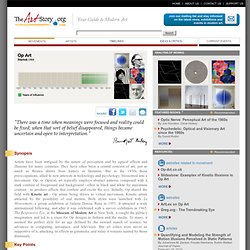
" Synopsis Artists have been intrigued by the nature of perception and by optical effects and illusions for many centuries. They have often been a central concern of art, just as much as themes drawn from history or literature. But in the 1950s these preoccupations, allied to new interests in technology and psychology, blossomed into a movement. Op, or Optical, art typically employs abstract patterns composed with a stark contrast of foreground and background - often in black and white for maximum contrast - to produce effects that confuse and excite the eye.
Key Points The Op art movement was driven by artists who were interested in investigating various perceptual effects. Although Op can be seen as the successor to geometric abstraction, its stress on illusion and perception suggests that it might also have older ancestors. Vvvv - a multipurpose toolkit. Create Digital Motion - Nightly.
About - GENERATIVE GESTALTUNG. Forms (process) on Vimeo - Nightly. Blog + News » New Media Artworks: Prequels to Everyday Life - Nightly. As an occasional emissary for new-media arts, I increasingly find myself pointing out how some of today’s most commonplace and widely-appreciated technologies were initially conceived and prototyped, years ago, by new-media artists.

In some instances, we can pick out the unmistakable signature of a single person’s original artistic idea, released into the world decades ahead of its time — perhaps even dismissed, in its day, as useless or impractical — which after complex chains of influence and reinterpretation has become absorbed, generations of computers later, into the culture as an everyday product. This story forms the core argument for including artists in the DNA of any serious technology research laboratory (as was practiced at Xerox PARC, the MIT Media Laboratory, and the Atari Research Lab, to name just a few examples): the artists posed novel questions which wouldn’t have arisen otherwise.
STRANDBEEST - Nightly. Rosemary Hill · At the Hayward: David Shrigley · LRB 23 February 2012 - Nightly. There has been a certain amount of huffing and puffing among the usually imperturbable gallery-going set about David Shrigley’s Brain Activity exhibition at the Hayward (until 13 May).

People who value the power of art to shock far too highly ever to be shocked by it themselves, have nevertheless been somewhat put out, complaining that Shrigley, who is best known as a cartoonist, should have been given a solo show in such a prominent venue for serious modern art. Shrigley himself, who describes his work as ‘somewhere between handwriting and drawing’, and furthermore ‘not the kind of drawing where you’re trying to get their eyes in the right place’, has confirmed that he is being taken ‘far more seriously’ than he should be. It is the irony of course that annoys his critics as much as anything.
At the simple level of taxonomy the exhibition shows him to be more than a cartoonist. The dreadful luminosity of everything. (On light: the title is taken from Kei Miller’s A Light song of Light, which says all of this so much better.)
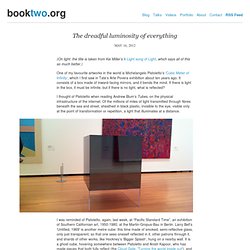
One of my favourite artworks in the world is Michelangelo Pistoletto’s ‘Cubic Meter of Infinity‘, which I first saw in Tate’s Arte Povera exhibition about ten years ago. It consists of a box made of inward-facing mirrors, and it bends the mind. If there is light in the box, it must be infinite, but if there is no light, what is reflected? I thought of Pistoletto when reading Andrew Blum’s Tubes, on the physical infrastructure of the internet. Michelangelo Pistoletto - Nightly. Michelangelo Pistoletto - Nightly. In 1961, after making a series of reflecting black-ground paintings significantly entitled The Present , Pistoletto conducted a series of experiments intended to achieve the highest degree of objectivity—the kind of objectivity shown in the early mirror paintings.
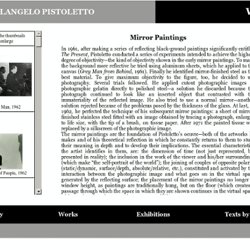
To make the background more reflective he tried using aluminum sheets, which he applied to the canvas ( Grey Man from Behind , 1961). Finally he identified mirror-finished steel as the best material. To give maximum objectivity to the figure, too, he decided to use photography. Several trials followed. He applied cutout photographic images or photographic gelatin directly to polished steel—a solution he discarded because the photograph continued to look like an inserted object that contrasted with the immateriality of the reflected image. “I realized there wasn’t any sort of assent or interest around me: in fact there was a certain nervousness and rejection, mainly by the gallery owner himself.
Cool shit on Vimeo - Nightly.
Neil Freeman – fake is the new real - Nightly. Stop-action. Open source Graphic Design - Nightly. How to work as a Graphic Designer without sleeping with Adobe I am just now completing a certificate in graphic design at the online school Sessions.edu, and although I have come to like the Adobe Creative suite tool (and mainly inDesign), I would rather be relying only on open source tools.
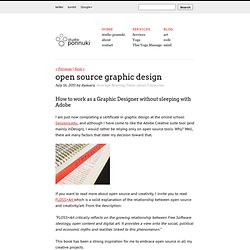
Why? Well, there are many factors that steer my decision toward that. If you want to read more about open source and creativity, I invite you to read FLOSS+Art which is a solid explanation of the relationship between open source and creativity/art. From the description: “FLOSS+Art critically reflects on the growing relationship between Free Software ideology, open content and digital art. This book has been a strong inspiration for me to embrace open source in all my creative projects. Using open source instead of a licensed software is quite empowering and freeing. . + Free software – meaning you don’t pay for it (you still can donate what you want!)
Photoshop replacement with GIMP Other useful tools. True Structure: ZigZag® - Nightly. Zztop-D1501.01.11 •The ZIGZAG® DATABASEandVISUALIZATION SYSTEMThe true generalization of structure (still in prototype) For the true generalization of documents and media,see Project Xanadu.
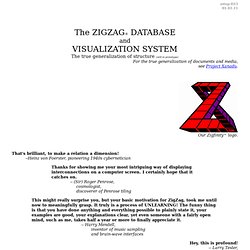
Our Zigfinity™ logo. •That's brilliant, to make a relation a dimension! --Heinz von Foerster, pioneering 1940s cybernetician Thanks for showing me your most intriguing way of displaying interconnections on a computer screen. I certainly hope that it catches on. -- (Sir) Roger Penrose, cosmologist, discoverer of Penrose tiling This might really surprise you, but your basic motivation for ZigZag, took me until now to meaningfully grasp. Hey, this is profound!
Nelson - Nightly. 1 Preliminary remarks Science is supposedly about universals.
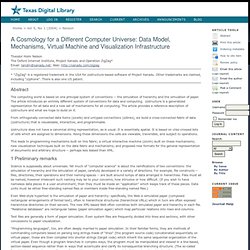
Yet much of "computer science" is about the ramifications of two conventions: the simulation of hierarchy and the simulation of paper, carefully developed in a variety of directions. For example, file constructs -- files, directories, their operations and their naming-spaces -- are built around lumps of data arranged in hierarchies. Files must all be named, however irrelevant such naming may be to your concerns, how intrusive or how difficult. (If you wish to have nameless data pieces in a user environment, then they must be inside an "application" which keeps track of these pieces. Nightly. AntiVJ is a visual label - Nightly. Degree Confluence Project Composite World Map - Nightly. Degree Confluence Project Composite World Map - Nightly. A Historic look at the world of yesterday, today and tomorrow - Nightly. World History : HyperHistory - Nightly.
About - Nightly.
Aurasma - Nightly. Reflect.